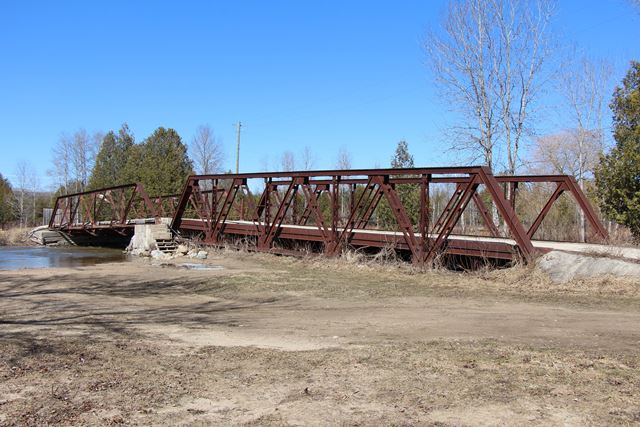We Recommend:
Bach Steel - Experts at historic truss bridge restoration.
BridgeHunter.com Phase 1 is released to the public! - Visit Now
Saugeen Cedars Bridge
Hawk's Crossing

Primary Photographer(s): Nathan Holth and Rick McOmber
Bridge Documented: April 11, 2015
West Grey (Near Hanover): Grey County, Ontario: Canada
By Builder/Contractor: Unknown
Not Available or Not Applicable
Not Available
Not Available
Not Available
2 Main Span(s)
Not Applicable

View Information About HSR Ratings
Bridge Documentation
Visit The Saugeen Cedars Family Campground Website
This is a unique bridge. It is quite apparent just from looking at the bridge that two different single truss bridge spans were acquired by this campground and placed here on homemade abutments and pier to form a two-span bridge for the use of campground visitors. The decision to reuse these bridges by the campground likely saved these two heritage bridges from being destroyed and lost forever. Instead, the spans today form a unique and functional bridge, and are an example of how heritage bridges can be preserved while serving a new functional use. As heritage bridges, they also add beauty and history to the campground, something that a modern bridge would have been unable to provide.
The two bridges make an interesting comparison to each other. Although both are rivet-connected Warren pony trusses, each span is quite different. The northern span is a bit shorter, and has four panels, while the longer southern span has five panels. The northern span is a lightweight and simple design, with chords and members composed of simple paired angles. It also has outriggers for stability, which are composed of angle as well. In contrast, the southern span has a heavier and more complex design composed of diagonal members: two angles with battens, vertical members: two angles with lattice bars, top chord: back-to-back channels with cover plate and battens, and finally bottom chord: paired angles. The heavier design, despite being taller, did not need the stabilization of outriggers, and as such has none. Typically, heavier truss bridges suggest a newer bridge, while older bridges tend to have lighter weight construction. Similarly, older bridges tend to have narrower roadways, while newer bridges have wider roadways. However, with these two spans, the heavier southern span has a narrower roadway. The construction date and origin is unknown for both spans.

![]()
Photo Galleries and Videos: Saugeen Cedars Bridge
Bridge Photo-Documentation
Original / Full Size PhotosA collection of overview and detail photos. This gallery offers photos in the highest available resolution and file size in a touch-friendly popup viewer.
Alternatively, Browse Without Using Viewer
![]()
Bridge Photo-Documentation
Mobile Optimized PhotosA collection of overview and detail photos. This gallery features data-friendly, fast-loading photos in a touch-friendly popup viewer.
Alternatively, Browse Without Using Viewer
![]()
Maps and Links: Saugeen Cedars Bridge
Note that this bridge is located in a campground and not on a public road. Please respect the rights and rules of the owner.
Coordinates (Latitude, Longitude):
Search For Additional Bridge Listings:
Additional Maps:
Google Streetview (If Available)
GeoHack (Additional Links and Coordinates)
Apple Maps (Via DuckDuckGo Search)
Apple Maps (Apple devices only)
Android: Open Location In Your Map or GPS App
Flickr Gallery (Find Nearby Photos)
Wikimedia Commons (Find Nearby Photos)
Directions Via Sygic For Android
Directions Via Sygic For iOS and Android Dolphin Browser

